4 Ways to Make the Most of a Small Japanese Apartment
So you’ve found the perfect Tokyo apartment but there’s just one problem – it’s much smaller than you expected. Luckily, Japanese people are masters of making the most of small spaces and creating clever storage solutions.
Here’s our advice on how to best utilize the space you have available.
1. Consider Japanese Furniture
Generally speaking, room sizes in Japan are a lot smaller than in western countries. For a good idea on what to expect, check out our guide on how much IKEA furniture you can expect to fit in an average Japanese size apartment.
Although IKEA furniture is very popular here, and perfectly suitable for Japanese homes, it’s also worth taking a look at furniture brands that are specially made for the Japanese market. One such brand, Nitori (commonly referred to as the Japanese IKEA), has stores located all across Japan, as well as an online store. Another popular brand is Muji, which has recently found popularity overseas.

Dining room by Nitori
Furniture made for Japan is more compact and tailored to the lifestyles of people in smaller homes. Traditional furniture such as futons and floor chairs are designed to fit inside Japanese cupboards. By switching out the furniture, a room can be a bedroom in the evening and living space during the day. There are also Japanese versions of western furniture, such as sofas and dining tables. They are built to be slightly smaller and lower than average, taking up less space. Low-rising furniture can also make your ceiling seem higher, creating an illusion of more space.
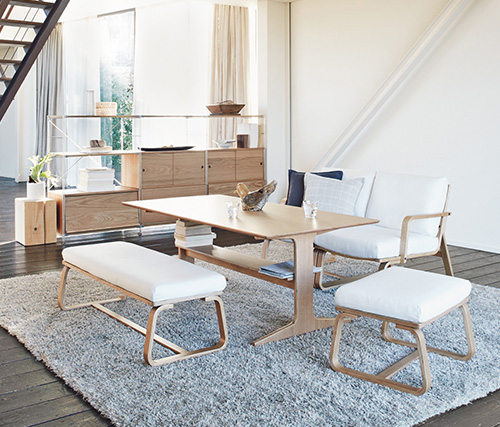
Dining room by MUJI
Nitori, Muji, and Amazon Japan are also great places to look for shelving and storage units that are made to fit in cupboards and small spaces.
2. Choose Multipurpose Items
If you’ve been looking at apartments in Japan, you may be surprised by the number of studio and single bedroom properties. People from countries like Canada and the US are used to having more rooms that serve single purposes, such as a lounge room just for watching tv or a home office. However, due to the more compact nature of apartments in Japan, you are likely to find yourself using the same room for multiple purposes.
Examples of double function furniture include beds with drawers underneath, loft beds with room for a desk or wardrobe space underneath, and tables with inbuilt storage space.

Dining table with storage from Nitori (source)
This “living-dining set” by Nitori comes with an adjustable table that can be used for dining or as a coffee table. The lounge section can be used for storage or rearranged into a sofa bed. That’s a dining area, lounge room, and guest bedroom all in one!

Living-Dining Set from Nitori (source)

Converts to a sofa bed with storage
A very Japanese-style example is tatami units. These build-yourself tatami mat rooms create a platform with room for relaxing on top and a huge amount of storage underneath.
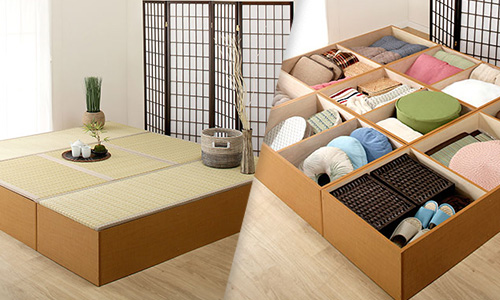
Tatami Unit by Nitori (source)
3. Use Tension Rods
High tension rods, or tsuppari bō (突っ張り棒) in Japanese, are adjustable poles which, if used correctly, leave no markings on your walls. Tension rods made in Japan are particularly sturdy and come with all sorts of accessories, allowing them to be used for a variety of purposes.
For example, horizontal tension rods can be installed in alcoves to create storage space or in a bathroom to make a clothesline; and a vertical pole between the roof and floor can be used to make a coat rack or shelves. Although some high tension poles can hold 30kg (66lbs) or more, be careful not to overload them. If they fall, the stoppers can drag and damage your wallpaper.

Heian Shindo brand tension rod (Amazon)

Lowya brand tension rod (Amazon)

Yamazen brand tension rod (Amazon)
Extra long tension rods can also be used to hang a curtain across a room and create two separate spaces.

Curtain tension rod (Amazon)
4. Don’t Hide Everything Away
Minimalists won’t like this one! However, if you are really short on space it’s not always possible to keep everything in a cupboard. In this case, try dividing your belongings into things you prefer to hide and things to put on display. This helps you make the most of your limited storage space by only using it for items that need to be kept out of sight.
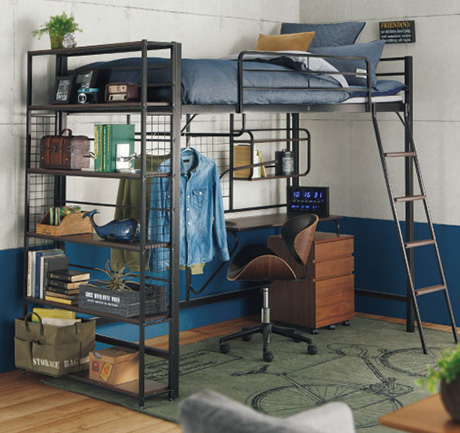
Loft bed with open storage by Nitori (source)
Items you wish to hide can be put under the bed or in a closet, and things you’re happy to show can be neatly organized on a wall rack or shelving unit. If you live in a studio apartment, consider using shelves as a wall divider to separate living and bedroom spaces. As well as being great storage, open shelving allows light to pass through. This keeps the room feeling spacious without blocking the air flowing from windows or your air conditioner.
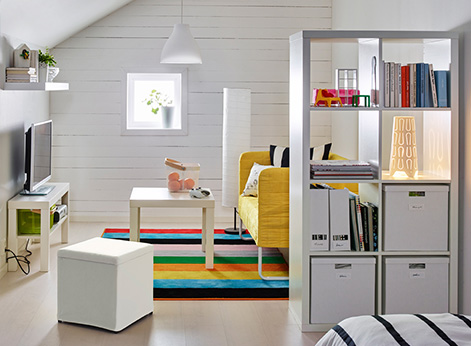
KALLAX shelving unit by IKEA (source)
Books and photos are often openly displayed in homes, and items such as nice handbags and hats (which can take up a lot of wardrobe space) can also look good out on show. In the kitchen, consider hanging up your pots and pans, and keeping basics like flour and sugar in stylish jars on the shelf. Plates and glasses can also look great if they are neatly arranged but may fall and break during an earthquake, so make sure to put them on non-slip padding or in a cabinet with doors.
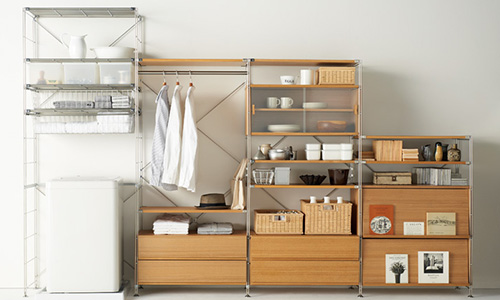
Unit Shelf by MUJI (source)
We hope this article has given you a few ideas for furnishing your home! It can take some getting used to, but you might be pleasantly surprised by how comfortable it can be living in a smaller space.
Click here to read more of our articles about Japanese apartment living and interior design.
Looking for an apartment in Tokyo?
Contact us with your criteria!
We love the challenge of finding the perfect apartment to suit our clients’ personalities, requirements, and lifestyle.
